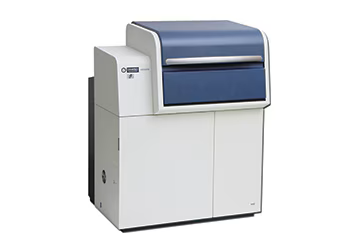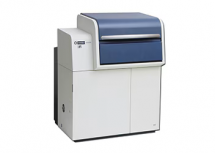Small signal level differences at detector switching afford highly accurate measurements even when the wavelength of detector is being switched.
Multiple detectors are installed in the integrating sphere to perform measurement over a wide range of wavelengths, from ultraviolet to visible to near infrared regions. The changes in photometric values at detector switching (from signal level differences) are minimized due to a design utilizing Hitachi’s expertise in integrating sphere construction, signal processing technologies, etc.
Low stray light and low polarization characteristics are attained with Hitachi’s high-performance prism-grating double monochromator system
The UH4150 adopts a prism-grating (P-G) double monochromator optical system, continuing the established reputation of the U-4100 optical system. Large changes in light intensity of the S and P polarization are less likely for the prism-grating (P-G) system than for the generally used grating-grating (G-G) system. The UH4150 offers low noise measurements, even for low transmittance and reflectance samples.
Collimated light beam allows accurate measurement of reflected light and scattered light.
The incident angle is important for the measurement of specular reflectance of solid samples. For focused light beam, the incident angle varies depending on the lens’s focal length, etc. Consequently, the values of simulation of design of optical thin films, such as dielectric multilayer film and prism, would differ from actual measured values. In the case of a collimated light beam, however, the incident angle is always the same with respect to the sample, leading to a highly accurate measurement of specular reflectance. Moreover, the collimated light beam is useful for the evaluation of diffusivity (haze) and the measurement of transmittance of lenses.
A wide variety of detectors affords the selection of detectors suitable for measurement objectives.
Eight types of integrating spheres of different materials, sizes, and shapes are available
New ergonomic design has been adopted.
The door of sample compartment is modified to improve the operation. An ergonomic design is adopted by taking into account the operation of replacing samples and accessories.Compatible with many of the U-4100 accessories. Common accessories are available for both models. Accessories used with Model U-4100 can also be used with Model UH4150.
Higher throughput than Model U-4100.
While maintaining the high-performing optical system of the model U-4100, the UH4150 provides higher throughput measurements. In the previous model, a scan speed of 600 mm/min was necessary for a measurement using a data interval of 1 nm. With Model UH4150, you can measure at 1 nm intervals while using a scan speed of 1,200 nm/min, reducing the measurement time significantly.*5 The UH4150 measures from 240 to 2,600 nm in approximately two minutes. It is effective for samples requiring measurement in UV-VIS-NIR wavelength range, such as Solar Reflective Materials.

 SingaporeSG
SingaporeSG ChinaCN
ChinaCN MalaysiaMY
MalaysiaMY IndonesiaID
IndonesiaID MyanmarMM
MyanmarMM


